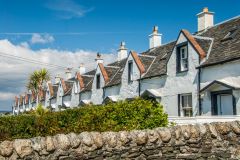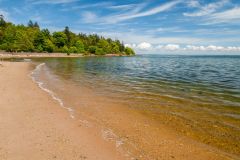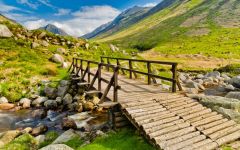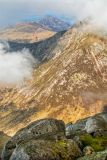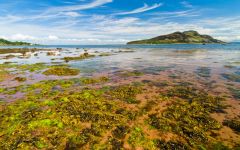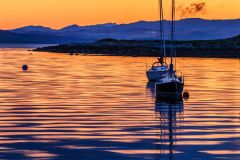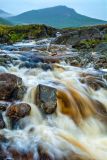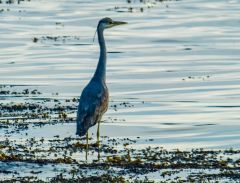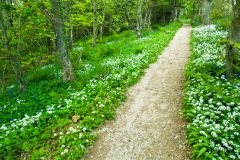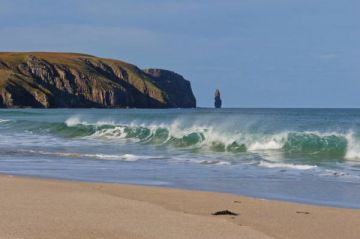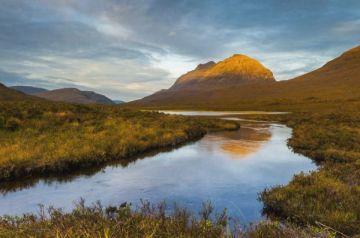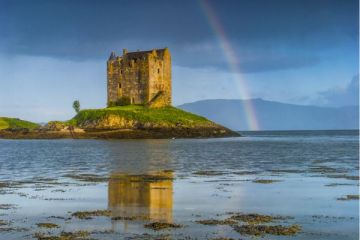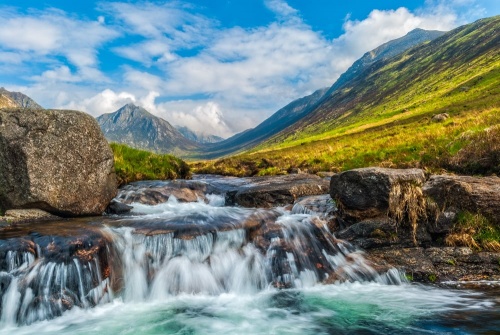
Arran is the largest island in the Firth of Clyde, lying between the Kintyre peninsula and the west coast of Ayrshire. At 167 square miles (432 sq km) it is the seventh-largest Scottish island. The island's profile when viewed from the Ayrshire coast has given it the moniker, 'The Sleeping Warrior', since it seems to resemble a prone human figure.
Scotland in Miniature
Arran is even more frequently referred to as 'Scotland in Miniature' because its geology and geography echos that of Scotland as a whole, with rugged highlands in the north and fertile lowland areas to the south. Dividing the highland and lowland areas is the Highland Boundary Fault.
The highest peak in the Arran Highlands is Goatfell (sometimes spelled in two words as Goat Fell), which rises immediately northwest of Brodick and reaches 873.5 metres (2,866 feet). Well-trodden trails lead past the Brodick Castle grounds and climb to the summit for exceptional views. Goatfell is preserved by the National Trust for Scotland, who also look after the historic stately home of Brodick Castle.
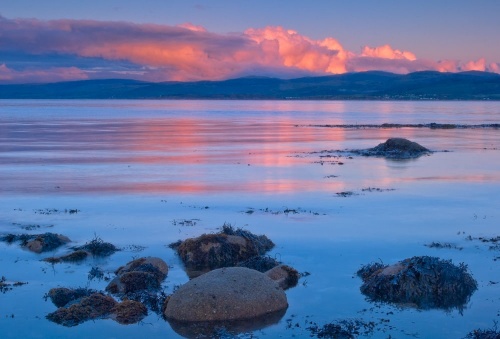
Most of Arran's population lives around the coast, particularly the east coast, which is sheltered from the prevailing winds and has a milder climate than the west and south coasts.
At the northern tip of the island is Lochranza, famous for its native herd of red deer, which can often be seen drinking at the edge of the loch. On a spit of land stretching out into Loch Ranza is Lochranza Castle, a medieval house later converted into a 16th-century fortified tower house. Lochranza is home to one of two distilleries on the island.
Just down the west coast from Lochranza is the picturesque village of Catacol, famous for its row of terraced 19th-century cottages known as the Twelve Apostles. Each of the cottages has a differently shaped first-floor window, so that the woman of the house could signal to their menfolk fishing in the bay.
Near Catacol, signposted trails lead inland up Glen Catacol and, further south, to Coire Fhionn Lochan.
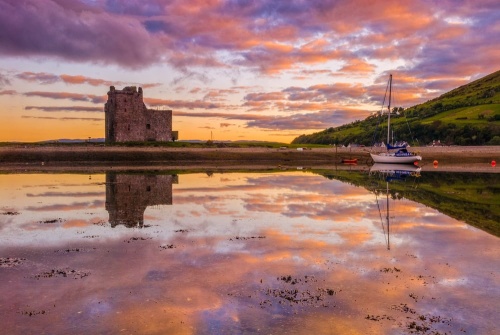
In the southwestern corner of Arran is Blackwaterfoot, built around a pretty little harbour. The village is famous for its 19th-century 12-hole golf course, one of only two in Scotland. On the edge of Blackaterfoot is The Doon Iron Age Hillfort, defended from the sea by sheer cliffs and from the land by an overgrown stone wall.
At Kildonan, standing above the foreshore, are the ruins of 13th-century Kildonan Castle, built by the MacDonald Lords of the Isles to guard the approaches to the Firth of Clyde. It was allowed to fall into ruin in the 16th century.
In the southeastern corner of Arran is Whiting Bay, which grew up as a popular destination for tourists in the Victorian period, with day-trippers coming from the Scottish mainland. From Whiting Bay, a trail leads west, following Glenashdale Burn, to dramatic waterfalls.
Further north is Lamlash, the largest village on Arran. Separated from Lamlash by a shallow straight is Holy Isle, now home to a Tibetan Buddhist centre but once a refuge for early Christians.
If you follow the A841 coastal road north from Lamlash you soon come to Brodick, where most visitors to Arran come ashore at the Ardrossan ferry terminal. Don't miss the Arran Heritage Museum, formed from a collection of historic buildings. Here you can discover more about Arran's rich cultural heritage.
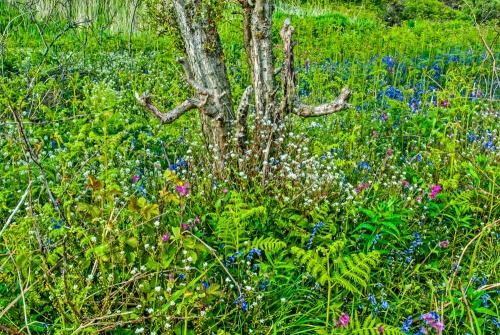
Prehistoric Sites
Arran was settled at least as early as the Neolithic period (roughly c. 4500 BC–1700 BC). Over 1000 prehistoric sites have been identified on the island.
Arran has an outstanding collection of Neolithic burial sites, many in the Clyde Cairn style of chambered cairn, consisting of a stone-built chamber with a cairn of small stones built over the chamber to create a cairn.
As the name suggests, these Clyde cairns can be found around the Firth of Clyde. They consist of a burial chamber near the widest end of a trapezoidal cairn, with a semi-circular forecourt at the entrance.
Perhaps the best example of Neolithic chambered cairns are the two examples at the Giants' Graves, above Lamlash.
The best-known prehistoric site on Arran is the complex of standing stones, stone circles, and burial sites at Machrie Moor, north of Blackwaterfoot. There are at least six stone circles at Machrie Moor, making it among the most interesting prehistoric sites in southern Scotland.
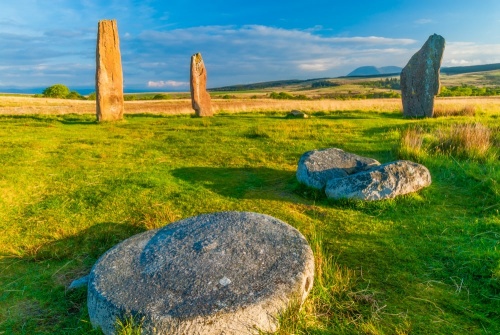
Further south is the Iron Age hillfort called The Doon, and beyond Blackwaterfoot is another Iron Age dun at Torr a' Chaisteal. Nearby is Kilpatrick Dun, a complex of ancient structures variously described as a dun, or fort, and a cashel associated with a monastery founded by St Brandon. Also nearby is Torrylin Cairn, a Neolithic chambered cairn in a fabulous location looking south to Ailsa Craig.
Irish missionaries came to Arran at least as early as the 6th century. St Brendan is thought to have established a monastery on the island, while his follower, St Molaise, had a cell on Holy Island, near a holy well that bears his name.
From the 11th century, Arran was part of the Kingdom of Mann and the Isles, including the Isle of Man and many of the Hebridean islands. In 1095 the islands came briefly under the direct rule of Norway but the islands returned to local rule a few years later and formed part of a Norse-Irish-Gaelic kingdom until 1237 when the Scottish islands broke away from the Isle of Man.
In 1263 Haakon Haakonsson, King of Norway, tried to reestablish Norse control, and gave Arran to Murdoch MacSween, but when Haakon died, Norway was forced to relinquish the islands to the Scottish crown. The most substantial reminder of the Norse presence on Arran is a Viking grave at King's Cross, near Lamlash.
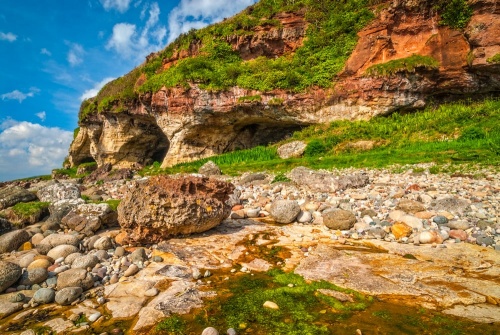
Robert Bruce is thought to have sheltered on Arran when fleeing for his life in 1306. A cave north of Blackwaterfoot is known as the King's Cave and is traditionally said to be the place where Bruce was inspired by watching a spider trying to spin its web to try again to claim the Scottish throne. Bruce returned to Arran the following year before sailing to the Scottish mainland and eventual success.
Bruce may have stayed for a time at Brodick Castle, founded sometime in the 13th century. The castle was captured by English troops on several occasions. It was for many years home to the Stewarts of Menteith. Very little remains of the medieval fortress; what we see today is an opulent stately home dating mainly to the 19th century.
In 1503 James, 2nd Lord Hamilton, was named Earl of Arran by James IV and the Hamilton family controlled the island for centuries. In the early 19th century the 10th Duke of Hamilton launched a devastating programme of clearances, moving families off the land they had farmed for centuries.
The result was catastrophic; whole villages were depopulated, and many families emigrated to Canada. A memorial to those who left the island during the Clearances stands near Hamilton Terrace in Lamlash.
Today, Arran no longer relies on fishing and agriculture, but on tourism. There are only three major roads (the term 'major' may be misleading, as only one is classified as an A road). There is also a public bus service, with a depot near the Brodick ferry terminal.
Arran is heaven for walkers; the Arran Coastal Way long-distance trail circles the island, and there are numerous signposted footpaths into the glens and up the peaks of the northern Highlands.
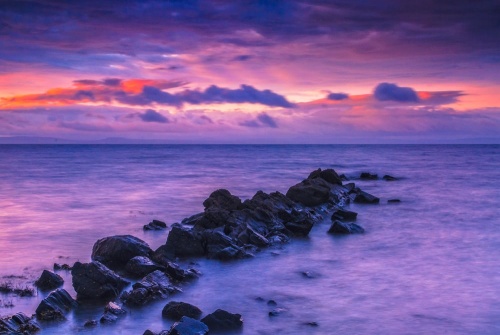
Getting There
Arran is linked to the mainland by two ferry routes. Brodick is connected to Ardrossan in Ayrshire, and Lochranza is connected to Claonaig and Tarbert. In summer there is a ferry between Lamlash and Holy Island.
Accommodation
Arran is extremely popular as a holiday destination, not surprising when you consider how close it is to the Scottish mainland. Most of the self-catering accommodation centres around the holiday centres of Whiting Bay, Lamlash, and Blackwaterfoot. There are also roughly a dozen hotels, most of them around Brodick, but others scattered around the island's coast. If you're on a budget, there is a popular youth hostel at Lochranza.
We spent a week at a holiday cottage at Imachar, on the west coast, and loved it. There were amazing sunsets looking west towards Kintyre, and by using the String Road between Machrie and Brodick we could be almost anywhere on Arran within 45 minutes.
